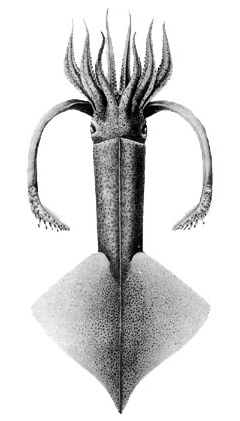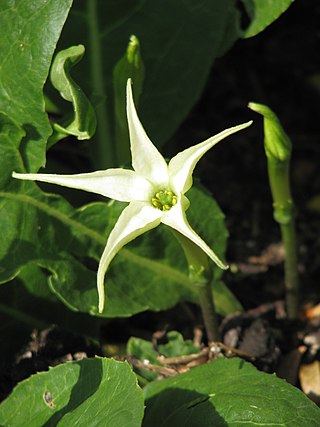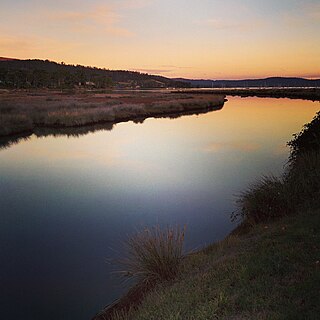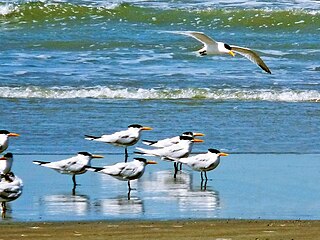
The roseate tern is a species of tern in the family Laridae. The genus name Sterna is derived from Old English "stearn", "tern", and the specific dougallii refers to Scottish physician and collector Dr Peter McDougall (1777–1814). "Roseate" refers to the bird's pink breast in breeding plumage.

The greater crested tern, also called crested tern or swift tern, is a tern in the family Laridae that nests in dense colonies on coastlines and islands in the tropical and subtropical Old World. Its five subspecies breed in the area from South Africa around the Indian Ocean to the central Pacific and Australia, all populations dispersing widely from the breeding range after nesting. This large tern is closely related to the royal and lesser crested terns, but can be distinguished by its size and bill colour.
{{Automatic taxobox | name = Hooked squid

Barunguba / Montague Island is a continental island contained within the Montague Island Nature Reserve, a protected nature reserve that is located offshore from the South Coast region of New South Wales, in eastern Australia. The nearest town located onshore from the 81-hectare (200-acre) reserve and island is Narooma, situated approximately 9 kilometres (5.6 mi) to the northwest.

The naked characin is a small species of fish in the family Characidae. It is the southernmost member of the family and the only member of the genus Gymnocharacinus. It is endemic to a stream near Valcheta in northern Patagonia, Argentina. Adults have no scales. It is endangered because of habitat loss.
Guzmania bergii is a species of plant in the family Bromeliaceae. It is endemic to Ecuador. Its natural habitat is subtropical or tropical moist montane forests. It is threatened by habitat loss.
Pitcairnia bergii is a species of plant in the family Bromeliaceae. It is endemic to Ecuador, where it is known from only two subpopulations in El Oro Province. It grows in the forests of the lower Andes, where it is threatened by habitat destruction.

Onychoteuthis is a genus of squid in the family Onychoteuthidae. The type species is Onychoteuthis bergii. While the genus is found worldwide in tropical and subtropical oceans, they can also occur in the North Pacific Ocean. There were previously considered to be four species in the genus but there are now considered to be roughly 10. These squid are frequently observed in the surface waters at night and they are often caught using dipnet at nightlight stations. The young squid are usually the only specimens captured using standard midwater trawls, the older squid are apparently able to avoid the trawls. They can, however be collected from the air as individuals are able to leap high out of the water, sometimes even landing on the deck of a ship.
Stenodrepanum bergii is a species of flowering plants in the legume family, Fabaceae. It is a perennial subshrub native to northern Argentina. It is the sole member of genus Stenodrepanum. It belongs to tribe Caesalpinieae in subfamily Caesalpinioideae.

Pao is a genus of mostly freshwater pufferfish with one species also occurring in brackish water. They are found in Southeast Asia. Until 2013, its species were generally placed in Tetraodon.
Taurocottus is a monospecific genus of marine ray-finned fish belonging to the family Cottidae, the typical sculpins. Its only species is Taurocottus bergii which is found in the northwestern Pacific Ocean. It occurs at depths of 40 to 120 m. This species grows to a maximum published standard length of 20 cm (7.9 in).

Jaborosa is a genus of flowering plants in the family Solanaceae, the nightshades. There are about 23 species, all native to South America, where they are distributed from Peru to Patagonia. Most occur in the Andes. Most can be found in Argentina and ten are endemic to the country.
Cap Island Conservation Park is a protected area in the Australian state of South Australia located about 7.5 kilometres (4.7 mi) offshore, west of Mount Misery, Eyre Peninsula. The park covers Cap Island's 8ha surface. The island consists of a granite base and a calcarenite mantle; its margins steeply over-hanging and eroded. Typical vegetation is a low Nitre Bush shrubland. Cap Island Conservation Park was constituted by statute in 1972 to conserve a sea bird breeding area and Australian Sea-lion and New Zealand Fur-seal haul-out areas.
Alatuncusia bergii, or Berg's alatuncusia moth, is a moth in the family Crambidae. It was described by Heinrich Benno Möschler in 1890. It is found in the West Indies, from Mexico to Venezuela and in southern Florida.
Saemundssonia laticaudata is an insect species first described in 1869. It is part of the Saemundssonia genus and the Philopteridae family. It is a parasite of the Greater crested tern.

The Port Cygnet Conservation Area is located in Cygnet, Tasmania, approximately 65 km (40 mi) southwest of the state's capital city, Hobart. The reserve has an area of 103 ha. It is an open estuary environment including a listed wetland of state significance, being the only Marine Protected Area (MPA) in the Bruny Bioregion representing the Open Estuaries Biounit.
Onychoteuthis bergii is a species of hooked squid from the family Onychoteuthidae. The species was originally described by Hinrich Lichtenstein from specimens taken near the Cape of Good Hope and is the type species of the genus Onychoteuthis. Until recently it was considered to be a junior synonym of Onychoteuthis banksii, but a re-examination of the type material, the lectotype and paralectotype which are deposited in the Natural History Museum, Berlin, showed that there were morphological differences which supported the status of O. bergii as a valid species. The species is found in the eastern South Atlantic and Indian Oceans.

The West African crested tern is a bird species in the family Laridae. Until 2020 it was considered a subspecies of the New World royal tern, Thalasseus maximus.

Ronderosia is a genus of spur-throated grasshoppers in the family Acrididae. There are about 10 described species in Ronderosia, found in South America.
Pao bergii is a species of pufferfish in the family Tetraodontidae. It is a tropical freshwater fish native to the Kapuas River drainage of Borneo in Indonesia.










